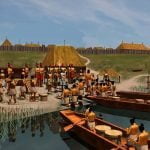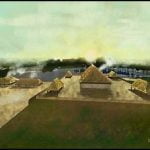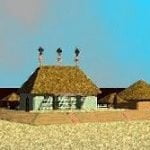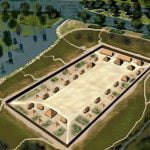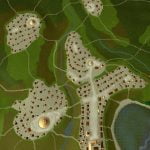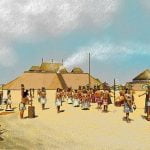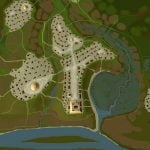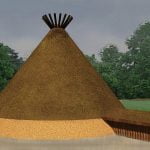Bibb County is located in central Georgia and is part of the Macon, GA Metropolitan Statistical Area (MSA.) It is named after William Wyatt Bibb (1781 -1820.) Its county seat is Macon.
Bibb County contains one of the most important and largest archaeological zones in the United States, the Ocmulgee Bottoms. It is one to two miles (1.6-3.2 km) wide and approximately 12 miles (19.2 km) wide. The Ocmulgee Bottoms was the location of one of the earliest centers of advanced Native American culture north of Mexico and the traditional location where the Creek Indian Confederacy was born. Ocmulgee National Monument in Macon contains the core cluster of ruins and village of the Ocmulgee Bottoms. The site of Fort Hawkins, the center of Federal government activities in the Southeast during the early 1800s, is also located in Macon.
Bibb County is bounded on the northeast by Jones County and the northwest by Monroe County. To the south is Houston County. It is bordered by Peach County to the south-southwest and Crawford County on the southwest side. Twiggs County is located to the east of Bibb.
William W. Bibb was born in Amelia County, VA. While a child, his family moved to Elbert County, GA along with many other Virginians. Elbert is located in the northeastern part of that state. He attended William & Mary College, and then the University of Pennsylvania, where he was awarded a doctorate in medicine. He returned to Elbert County in 1801 and briefly practiced medicine in the booming town of Petersburg, located at the confluence of the Savannah and Broad Rivers. Petersburg (now under Lake Russell) was located over the ruins of a large Muskogean town that had been visited by William Bartram in 1773. Many mounds were leveled to build the town, including a large spiral mound like the one that still exists near Macon in the Ocmulgee National Monument.
Bibb was elected to the U. S. House of Representatives in 1803 and served four terms. In 1813 he was elected to the U.S. Senate to complete a term of a senator who had resigned and served until 1816. While in Congress Bibb was an enthusiastic supporter of the efforts to remove the Creek Indians from Georgia and Alabama. He was appointed governor of the Territory of Alabama in 1816 as a reward for his support of the planter faction that desired Creeks lands for large scale cotton cultivation. In 1819 he was elected the first governor of Alabama in 1819. He died in office on July 20, 1820 from injuries in a horse-riding accident.
Geology and hydrology
Bibb County is located in the Piedmont, Sand Hills and Atlantic Coastal Plain geological regions. The northwest and north central portion of the county is in the Piedmont. The Sand Hills forms a band that crosses the county from west to east. The remainder of the county is in the Atlantic Coastal Plain. Along the Ocmulgee River the transition from igneous-metamorphic to sedimentary rocks is marked by drops in elevation, along with accompanying shoals and waterfalls. The transition zone is known in Georgia as the Fall Line.
The Lower Piedmont is characterized by underlying rock strata of igneous and metamorphicized igneous rock. The terrain consists of rolling hills and stream valleys. Seasonal or permanent wetlands parallel many of its streams. These are relatively narrow bands of soggy terrain that provide ecological diversity for animal and plant life. The top soils are thin over most hills and steep slopes, while much deeper near streams. Short-sighted cultivation techniques in the 19th and early 20th century caused much of the best top soil to be eroded; thus exposing red clay sub-soil. Sandy loam can still be found near streams.
The Macon Plateau is composed of a series of terraces overlooking the Ocmulgee River and Ocmulgee Bottoms that are a southern extension of the Piedmont. These terraces range from 50 to 75 feet (15-23 m) above the typical level of the Ocmulgee River. Observers standing on top of several terraces can see long distances to the south.
The Fall Line marks the boundary between metamorphosed igneous rock strata and sedimentary rock strata in the Southeastern United States. It corresponds to ancient boundary between land and ocean.. The relatively sudden drop in elevation causes rocky shoals along rivers and streams, which during the 1800s were ideal locations for water-powered industries.
The Sand Hills are located immediately south of the Fall Line. They are the remnants of barrier islands and sand dunes from the Miocene Era or about 20 million years ago. Because rain water drains rapidly through the sandy soil, this region is especially vulnerable to droughts. Only certain types of pines thrived in these regions. To early European settlers they were known as “pine barrens” or “deserts.” They were not desirable locations for permanent Native American towns because the soil was unfertile and the game was less plentiful. The Sand Hills did make good locations for winter encampments because the sandy soil quickly drained away winter rains and tended to absorb solar heat quicker than woodsy loam.
The Atlantic Coastal Plain is characterized by underlying rock strata that are relatively young sedimentary rock from the Late Cretaceous Period, when the shore of the Atlantic Ocean ran through present day Bibb County. Here the terrain is much more moderate than in the Piedmont, varying from gently rolling hills to flat bottomlands. The Ocmulgee Bottoms composes a large alluvial flood plain where the Ocmulgee River meanders through swamps and seasonal wetlands.
Bibb’s largest stream is the Ocmulgee River, which flows through the center of the county. Major tributaries of the Ocmulgee include Tobesofkee, Colaparchee, Echeconee, Rocky, Beaverdam, Stoney and Walnut Creeks. Tobesofkee, Echeconnee and Walnut Creeks were sufficiently deep to provide corridors for a Native American canoe transportation network in pre-European times.
The Ocmulgee River joins the Oconee River in southern Georgia to become the Altamaha River, which eventually reaches the Atlantic Ocean. Part of the Ocmulgee’s route along the edge of Bibb County is characterized by shoals. It is only navigable for canoes, kayaks and small row boats.
Ocmulgee is the Anglicization of the Georgia Muskogee-Creek tribal name, Oka-mole-ke, which means “Swirling Water People.” Georgia Muskogee was a mixture of the dominant Creek language, Itsate (Hitchiti) with the dialect of Muskogee spoken along the Tallapoosa River in Alabama.
Tobesofkee is the Anglicization of the Georgia Muskogee-Creek word, topah-sofkee, which means “hospitality shed,” but literally means “serving board-grits.” The topah-sofkee was a building in any Creek town or village of significant size that provided free, warm meals, 24 hours a day, seven days a week, to any traveler, hunter or hungry person.
Echeconnee is the Anglicization of the Itsate-Creek word, eco-kvnhe, meaning Deer Mound. The Muskogean “v” sound is pronounced like “aw” in paw, but was often interpreted by European speakers as an “o” sound.
Colaparchee probably is derived from the Georgia Muskogee-Creek word kolepah-che, which means “to have fireflies.” There is no “r” sound in Oklahama Muskogee, so perhaps the original word was Itsate-Creek and pronounced koleparchee. The Itsate Creeks did pronounce “r” sounds.
Native American occupation
In the past, Bibb County Native American populations were apparently concentrated along the Ocmulgee River Flood Plain, plus the larger creeks that flow into the Ocmulgee. There is evidence that the complex system of meandering streams, permanent swamps and seasonal wetlands in the Ocmulgee Bottoms, now known as the Bond Swamp National Wildlife Management Area were the locations of some the earliest experiments in agriculture in the United States.
The region around Bibb County was occupied by ancestors of the Creek Indians, when first visited by English traders in the late 1600s. However, linguistic evidence provided by the chronicles of the Hernando de Soto Expedition, when it passed through the region in spring of 1540, suggests that the members of the original Creek Confederacy included provinces from several ethnic groups, not just Muskogee-Creeks.
Maps of that era show the Ocmulgee – Creeks living around Indian Springs and the Upper Ocmulgee River, while the area around Ocmulgee National Monument in Macon is labeled “Ochesee” by the early maps of the Colony of Carolina. The Ocmulgee Creeks abandoned the Upper Ocmulgee River during the Yamasee War (1715-1717) and relocated to the Lower Chattahoochee River. Some of the Ocmulgee returned to the upper Ocmulgee River Basin after friendly relations were established with the new Colony of Georgia in 1732.
Throughout the 1700s and early 1800s, the Creek Indians were by far the largest tribe north of Mexico. However during the 1800s, they were repeatedly subdivided, assimilated, killed in battle or intentionally starved to death in concentration camps. Although they take a much lower profile than Cherokee descendants, there probably still many more people in the United States carrying at least some Muskogean DNA than any other tribe. However, the federally recognized Muscogee – Creek Nation of Oklahoma is only the fourth largest federally recognized tribe, behind the Navajo, Oklahoma Cherokees and Oklahoma Choctaws.
Native American Cultural Periods
Earliest Inhabitants
Archaeologists believe that humans have lived in Bibb County for at least 12,000 years, perhaps much longer. Clovis and Folsom points, associated with Late Ice age big game hunters have been found in the Ocmulgee River Valley. During the Ice Age, herds of giant mammals roamed the river bottom lands. The mastodons, saber tooth tigers, giant sloths and other massive mammals died out about 8,000 years ago. The ethnic identity of the Clovis Culture hunters is not known. They were long presumed to be American Indians, but recent research by anthropologists have revealed many similarities with the big game hunters of Western Europe. An ice cap on the North Atlantic Ocean may have permitted early humans to move back and forth between continents by paddling, while gaining sustenance from hunting sea mammals and fishing.
Archaic Period (8,000 BC – 1000 BC)
After the climate warmed, animals and plants typical of today soon predominated in this region. Humans adapted to the changes and gradually became more sophisticated. They adopted seasonal migratory patterns that maximized access to food resources. Archaic hunters probably moved to locations along major rivers during the winter, where they could eat fish and fresh water mussels, if game was not plentiful. During the remainder of the year, smaller streams would have been desirable camp sites.
Bibb County was an ideal location for bands of hunters and gatherers. The county’s network of creeks and wetlands provided a diverse ecological environment for game animals and edible plants. Native Americans learned to set massive brush fires in the late autumn which cleared the landscape of shrubs and created natural pastures for deer, bison and elk. The Georgia Piedmont had numerous Woodland bison until they were killed off by British settlers in the mid-1700s. The landscape that European settlers encountered in the Piedmont and Coastal Plain was not natural. It had been altered for thousands of years by Native Americans to create optimum environments for the natural production of food sources.
During the late Archaic Period, several trade routes developed in this region that interconnected the Atlantic Ocean, Gulf of Mexico, Appalachian Mountains and Great Lakes. During this time, Native Americans began traveling long distances to trade and socialize.
The earliest known pottery in the Western Hemisphere has been discovered by archaeologists in the middle Savannah River Valley and in middle Ocmulgee Basin. The makers of this pottery were probably hunters and gatherers, who spent significant portions of the year along the major rivers of eastern Georgia. It is known as Stallings Island pottery after Stallings Island near Augusta, GA. Archaeologists believe that the Stallings Island people first began experimenting with ceramics around 2,500 BC. This is slightly earlier that the first pottery produced in Mexico; in the Pacific Coast State of Guerrero. Most of Mexico would not have ceramics for at least another 800-1000 years.
Woodland Period (1000 BC – 900 AD)
The Etowah, Chattahoochee and Flint River Valleys were locations of some of the earliest permanent villages in North America. It is likely that permanent settlements in the upper Ocmulgee Basin followed soon afterward –possibly at the same time. A sedentary lifestyle was made possible by abundant natural food sources such as game, freshwater mussels and chestnuts and the cultivation of gardens. Agriculture came very early here. Initially, the cultivated plants were of indigenous origin and included a native squash, native sweet potato, sunflowers, Jerusalem artichoke, amaranth, sumpweed, and chenopodium.
The early villages were relatively small and dispersed. There was probably much socialization among these villages because of the need to find spouses that were not closely related. Houses were round and built out of saplings, river cane and thatch.
The Woodland Period peoples of the region built numerous mounds. Apparently, most mounds were primarily for burials, but may have also supported simple structures that were used for rituals or meetings. They were constructed accretionally. This means that the mounds grew in size over the generations by piling soil and detritus from the village over recent burials. Most had ovoid or circular footprints.
Archaeological evidence in the Chattahoochee and Flint River Valleys suggests that the first Muskogean farmers entered northeast Georgia around 400 BC, after migrating from west-central Mexico. However, the region was probably was already occupied by ancestors of the Yuchi and Southern Siouans with languages similar to the Catawba. There may have been other ethnic groups whose identities have been concealed by time. Agricultural technology, cultural traditions and DNA probably blended between these peoples. Modern “Creek” Indians may represent a genetic mix of several indigenous ethnic groups.
Around 100 AD, the ancestors of the Creek Indians evolved to building permanent towns with horseshoe shaped plazas for playing ball games, near the Chattahoochee and Ocmulgee Rivers. This was known as the Swift Creek Culture. Swift Creek Style pottery is considered some of the most beautiful every made in North America. The Swift Creek People were also known for their finely crafted copper tools, weapons and ornaments. They built both ellipsoid shaped accretional mounds and some large pyramidal mounds for temples.
Muskogean town dwellers (900 AD – 1784 AD)
Muskogeans carried with them advanced cultural traditions from Mexico and the Lower Mississippi Valley. The early Muskogeans eventually formed provinces that were governed by large towns. Prior to arrival of Europeans, there were no Indian “tribes.” The large towns were usually located in the bottomlands on major rivers such as the Chattahoochee and below the Fall Line along the Ocmulgee River. Smaller villages located near creeks. Native Americans continued to live in what is now Bibb County, but their populations were concentrated elsewhere.
One of the earliest “advanced” indigenous towns in the United States was founded on the Macon Plateau around 900 AD along the Ocmulgee River. Its founders were newcomers, who carried with them many Mesoamerican cultural traits. They may have been either Itza Mayas or the hybrid descendants of both Mayas and indigenous peoples. The language that most of the Creek Indians’ ancestors spoke in Georgia was Itsate (Hitchiti in English.) The Itza Maya’s also called themselves, Itsate. There are many Maya and Totonac words in the various dialects spoken by the Creek Indians that came from Mexico.
One of the strongest pieces of evidence linking the colonists of the Ocmulgee River with the Mayas is the presence of several hundred, ceramic brine drying trays, discovered by archaeologists in the 1930s. They vary from 2-3 feet (61-100 cm) in diameter. None are on display in the museum at Ocmulgee National Monument. Such trays are common among Maya towns near the coast of Mesoamerica.
The Guatemalan city of Waka was a salt trading center in which archaeologists also found hundreds of brine drying trays. The physiographic settings of Waka and Ocmulgee are identical. They are both located on terraces overlooking fall lines of a river. They are exactly the same distance from the coast. Both have inner harbors created from a meandering creek running through a swamp that was formerly a horseshoe bend of a river. Both are on terraces overlooking that river. Waka was abandoned about one to two decades before the town was founded on the Ocmulgee River in Georgia.
After the founding of the town on the Macon Plateau in Georgia, many provinces in the Southeast began to share common artistic symbols and agricultural lifestyles. Societies became more organized politically with elite families, non-agricultural specialists and local leaders. This era is known as the Southern Ceremonial Cult Period, Mississippian Period or Hierarchal Period.
he “Mississippian” label came from a conference at Harvard University in 1947 which adopted the inaccurate belief that all advanced Native American culture originated north of the Mason-Dixon Line along the Mississippi River. Villages located in Bibb County would have been highly influence by the cultural influence of regional centers such as the Ocmulgee mound complex in Macon, GA or the Abercrombie and Kyle mound complexes in Russell County, AL and Muscogee County, GA.
European exploration period (1540 AD – 1717 AD)
There is evidence that European diseases began affecting coastal populations as early as 1500 AD Native American traders carried the microbes northward from Cuba and then into the lowlands near the Atlantic Ocean and Gulf Coast. Shortly after the Hernando de Soto Expedition passed through Georgia in 1540, waves of European diseases began to decimate the Native American population. Hernando de Soto’s expedition. probably passed through or near Macon, GA in March of 1540. Thus, the indigenous people of Bibb County would have been exposed to deadly pathogens immediately. Anthropologists currently believe that the indigenous population of Georgia dropped about 95% between 1500 and 1700 AD.
Agricultural advancements: Almost immediately after Spanish missions were established on the coast of Georgia in the late 1500s, the ancestors of the Creeks were growing European fruits and vegetables in addition to their traditional crops. A Spanish expedition in 1600 observed peaches, pears and melons being grown in a village on the Ocmulgee River. By the 1700s, Creeks were also raising European livestock. Chickens and hogs were the first European animals acquired to supplement their turkey flocks and Mexican meat dogs. By the late 1700s, most Georgia Creek men owned horses and had become skilled herders of cattle, horses and hogs.
Creek Confederacy: The Creek Confederacy of “People of One Fire” was a political alliance formed by the remnants of many advanced indigenous provinces in the Lower Southeast. This alliance probably developed during the late 1600s. In Creek tradition the first capital of this alliance was at Achese (Ochesee) in what is now the Ocmulgee National Monument. Indian Springs, about 25 miles to the north in Butts County, continued to be a popular meeting place for leaders of the Creek Confederacy.
The member towns represented several ethnic groups, but the Muskogees and Itsati’s (Hitchitis) dominated the alliance. Muskogee was selected as the parliamentary language of the alliance. When British settlers first settled the coast of Georgia, Itsati was spoken by most Georgia Creeks. By 1800, a composite Muskogee language had became the spoken tongue of Creek citizens.
Dispersed farmsteads: 1780 AD – 1825 AD
After the American Revolution, Creek families dispersed across the vast territory now controlled by the Creek Confederacy. They lived in log cabins on farmsteads that differed little in appearance from Anglo-American farmsteads. Local histories that recall Creek village names from the 1800s are actually records of rural communities, where the farmsteads were closer together, not palisaded towns as in the pre-European days.
Almost immediately after the United States formed a permanent government, the Creeks were pressured to cede more and more land to the State of Georgia. By 1805 all land east of the Ocmulgee River had been ceded except of six square miles around the Ocmulgee Old Fields. Ocmulgee National Monument is now located in part of this reserve.
Within the Ocmulgee Reserve, Fort Benjamin Hawkins was constructed in 1806. It evolved into being the center of federal governmental operations in the Southeast. The fort’s period of most intense use occurred during the War of 1812, when it was the staging point for American operations against the British in Florida. In 1813 it was the staging point for U.S. Army operations against the Red Stick Creeks in Alabama, and later, against British invaders in southern Louisiana. After 1821 the fort’s functions diminished to that of an arsenal and militia center. It was formerly abandoned in 1828.
In 1821 mixed-heritage leader, William McIntosh persuaded the other leaders of the Creek Confederacy to cede a large tract of land along the west side of the Upper Ocmulgee River that included present day Bibb County. The Ocmulgee Reserve on the east side of the river was to remain as a location where assimilated Georgia Creeks could live, while protecting the ancestral Creek ruins.
At Indian Springs in 1825, McIntosh persuaded a relatively small number of minor Creek leaders in Georgia to cede all tribal lands in the state, including the Ocmulgee Reserve. The treaty did not have the support of the national leaders of the Creek Confederacy. Those Creeks signing the fraudulent treaty were rewarded with cash bribes and one square mile tracts of land, which they could either live on or sell to planters. McIntosh gave himself a reserve around Indian Springs, where he had constructed a hotel and plantation. Several signers of the fraudulent treaty including William McIntosh and a son of former Indian agent, Benjamin Hawkins, were executed for violating Creek law.
Protests from the legitimate Creek government leaders eventually caused the United States Senate to reject the treaty and demand that new negotiations be held with Creek leaders. However, by this time settlers and militiamen had driven many Creek households out of the state. A second treaty was approved by the official Creek leadership and United States Senate in 1827. It maintained the Ocmulgee Reserve. However, by this time, the reserve had been overrun by squatters, real estate speculators and politically powerful cotton planters. The Creek Nation was powerless to enforce their property rights.
Creek descendants today
Relationships between the Muskogee Creeks and their Anglo-European neighbors along the upper Ocmulgee River in the late 1700s were generally good. There was much intermarriage. However, there had been some violence along the Upper Oconee River during the late 1780s and early 1790s, between other branches of the Creeks and encroaching settlers. These problems ended with the 1802 and 1805 land cessions.
Creeks who were married to Caucasian or African spouses often remained in the Upper Ocmulgee Basin after it was ceded to Georgia. Some of their mixed heritage children remained in the region, while others moved to live among the Creeks. Also, some Creeks married African-American slaves then bought their freedom. The families in Bibb County, who proudly remember their Creek ancestry, are descended from the mixed heritage marriages with their European and African neighbors.



